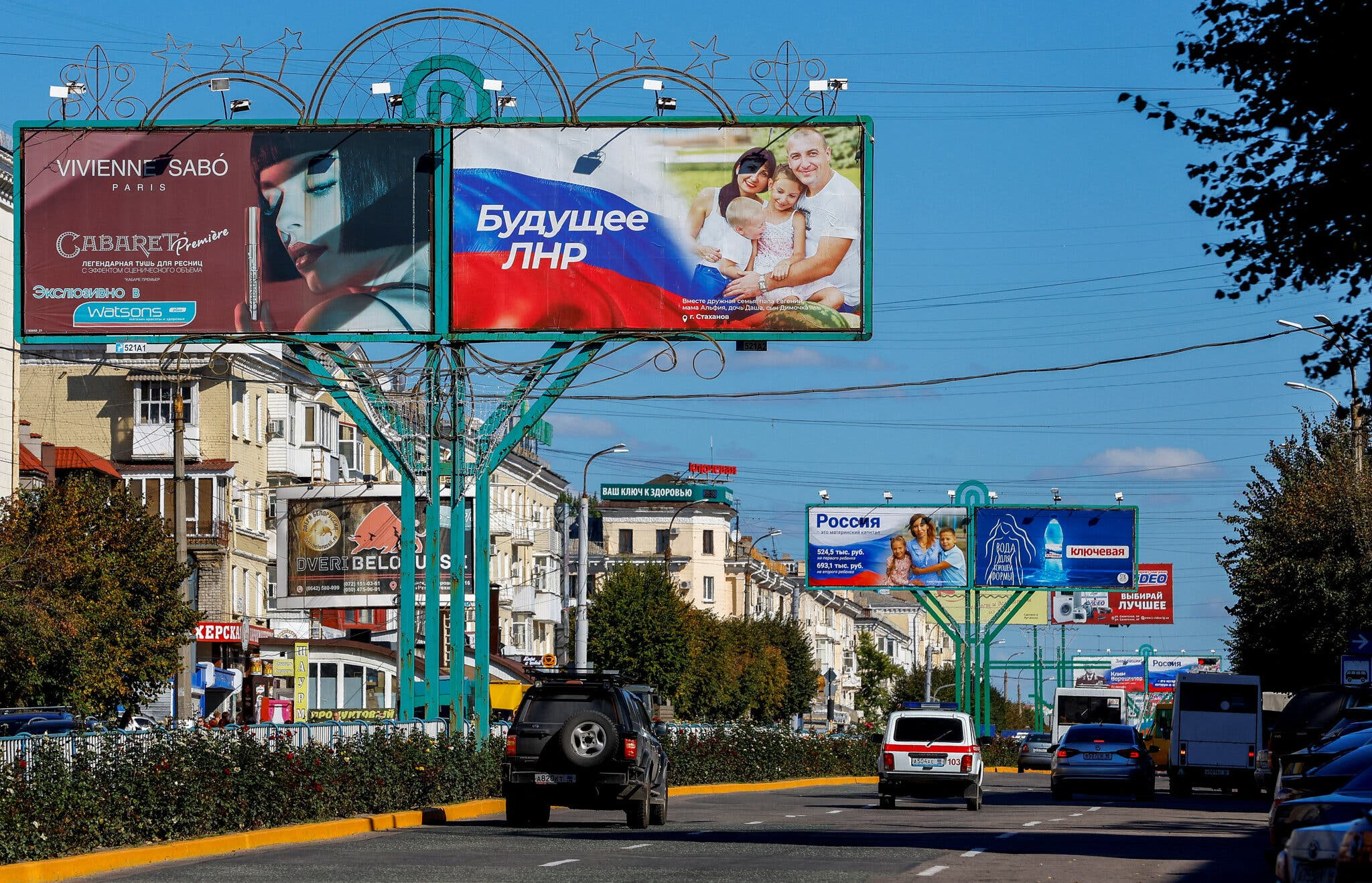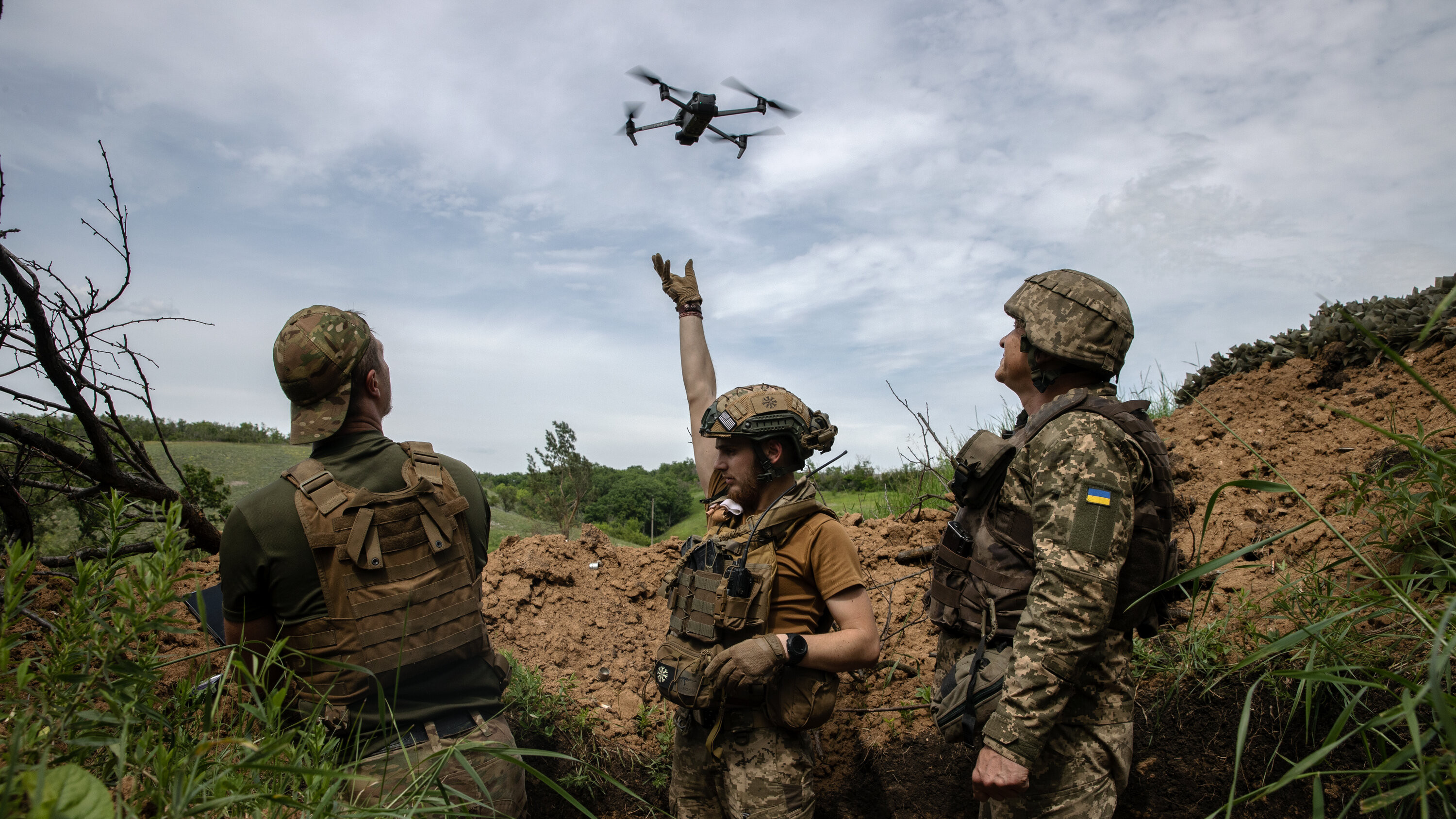Is a second Ukrainian invasion of Kursk taking shape? It’s not yet clear.
In a bold move on Thursday, Ukrainian engineers supported by drones and tanks breached Russian defenses along the Russia-Ukraine border, 20 miles west of Ukraine’s 400-square-mile salient in Russia’s Kursk Oblast.
The initial evidence indicated the Ukrainians breached the border defenses—berms, trenches and concrete tank obstacles—only to run into stiffer Russian resistance a short distance from the breach. The Kremlin claimed its troops defeated the Ukrainian attack “with the support of army aviation and artillery fire.”
The Ukrainian Khorne drone group, which supported the breaching operation, rejected the Kremlin’s claim—and criticized the media that covered the breach on Thursday. The reporters who cited the Kremlin’s claim are “hysterics who lack information or [are] paid pro-Russian psyops,” the group insisted.
As proof the Russians didn’t immediately defeat the Ukrainian incursion, the Khorne group posted a longer video depicting a Ukrainian armored column rolling through the breach and then speeding along the roads leading to the town of Veseloe, three miles from the border.
It seems at least one armored vehicle suffered damage, but the others ignored nearby artillery impacts and penetrated as far as the southern edge of Veseloe.
It’s unclear whether the Ukrainians advanced any farther on Thursday or Friday—and whether they were still in Veseloe or some nearby settlement as Saturday dawned.
Khorne projected strength. “We've advanced into new areas, by kilometers, into Russia,” the group stated. “A group of Russian conscripts numbering in the thousands is at risk of being encircled.” It’s not yet possible to independently verify that claim.
What is clear is that, for at least a few hours on Thursday—if not longer—Ukrainian troops invaded Russia for the second time in five weeks. The Ukrainian operation toward Veseloe kicked off just one day after Russian forces counterattacked the Ukrainians’ main salient in Kursk Oblast, ultimately recapturing a few outlying settlements.
How the Veseloe op might alter the dynamics of the chaotic fighting around the main salient remains to be seen. In the best case for Ukraine, a fresh cross-border attack might divert Russian troops from their counterattacks farther to the east.
In the worst case for Ukraine, the Kremlin’s claim was accurate—and the incursion into Veseloe, while initially successful, has already ended in a Ukrainian retreat.
Russia’s Counteroffensive in Kursk
“The Russians have begun counter-offensive actions” in Kursk Oblast, Ukrainian President Volodymyr Zelenskyy said on Thursday. Although information about Russia’s progress remains fragmentary, Moscow’s forces have retaken at least some territory. Here is what we know so far.
On September 10, Russian sources claimed that forces from the 155th Naval Infantry Brigade, 106th Airborne Division, and 7th Air Assault Division’s 56th Air Assault Regiment had begun attacking the western flank of Ukraine’s salient in Kursk Oblast. Forces from these units, which are among Russia’s better formations, had redeployed to the region after Kyiv launched its offensive on August 6.
On September 12, the Russian Defense Ministry alleged that its forces had retaken 10 villages over the prior two days. The status of most of those settlements remains unconfirmed. But Russian troops have made at least some progress.
On September 10, a Russian Telegram channel shared footage of eight tanks and other armored fighting vehicles from the 106th Division’s 51st Airborne Regiment entering the Ukrainian-controlled village of Snagost. They approached from the city of Korenevo to the northeast. The channel later posted footage of Ukrainian POWs purportedly captured in the Snagost area.
Reportedly, other Russian forces crossed the Seym River before launching attacks. Ukraine’s new Unmanned Systems Forces later shared footage of strikes on a Russian platoon-sized element and a Zemledeliye remote-mining system attempting to cross the Seym River north of the Russian-controlled town of Glushkovo.
On the morning of September 11, a Ukrainian volunteer and former soldier who supplies equipment to Ukrainian troops reported that Russian forces had “overwhelmed” troops from Ukraine’s 103rd Territorial Defense Brigade. He said that “drone operator positions were exposed,” resulting in “terrible consequences.” How much resistance Russian troops met in Snagost is uncertain, but they apparently cleared the village by September 13.
In addition to Snagost, troops from the 106th Division appear to have retaken the villages of Krasnooktyabr’skoe and Komarovka. (The extent to which Ukraine ever actually controlled the latter is unclear.) Forces from the 106th Division’s 137th Airborne Regiment also attacked northeast of Snagost toward Liubimovka. Taking Liubimovka would allow Russia to reach the Sudzha-Korenevo road, potentially encircling Ukrainian troops north of the village.
On September 11, the Ukrainian volunteer, along with some Russian sources, reported that Russian troops had reached the village of Obukhovka, southeast of Snagost. On September 13, however, the volunteer said Ukraine had retaken Obukhovka. The Russian Defense Ministry also reported a Ukrainian counterattack at Obukhovka but claimed it was unsuccessful. NASA satellite data on fires in the region provide further evidence that fighting has shifted from Snagost to the Obukhovka area.
Meanwhile, to the southwest, Ukraine has launched counterattacks in the Glushkovsky district, apparently aiming to disrupt the Russian attackers by threatening their rear. Video footage, along with reports by the Russian Defense Ministry and other Russian sources, indicate that Ukrainian armored fighting vehicles, supported by engineering equipment, have attacked toward the villages of Veseloe and Medvedzhe.
Ukrainian forces have also continued to conduct some attacks in the eastern and northern parts of their salient in Kursk Oblast, according to the Russian Defense Ministry. If true, this suggests Russia has not yet fully seized the operational initiative.
The Red Line’s New Crossroads
Several developments have taken place this week on the Ukraine-Russia war front that threatens to cross a rather significant “red line” in what has been a rather slow and steady crossing of red lines since Putin launched his invasion of Ukraine in March 2022.
The wider development is that the Biden Administration appears to be gearing up to remove restrictions on what weapons Ukraine can use in attacks on Russian territory. Specifically, the administration may allow Ukraine to use long-range missiles to target Russia–a move Putin on Thursday said would be tantamount to war with NATO.
Washington is possibly reacting to what it may view as increasing Russian weakness on the battlefield after the lack of direct response to Ukraine’s brazen incursion into Russia’s Kursk region, where it remains, holding territory. Rather than launching an immediate counteroffensive in Kursk, Russia chose to intensify its campaign of airstrikes and its push in Donbas as it seeks to sever a key element of Ukraine’s military supply chain.
The second development is that Russia has finally launched a counteroffensive in Kursk, the Russian territory that Ukraine launched an incursion into weeks ago, without a decisive response from Moscow. Ukrainian officials have also noted the build-up of Russian forces on the Ukraine-Belarus border, flanking Kursk.
Zelensky insists the Russian counteroffensive is unfolding in line with his strategy and claimed the Belarus border troop buildup was under control. The Russians are advancing towards Ukraine in the Kursk region, and Moscow says it has retaken control over 10 settlements. The advance appears to be fairly slow and in areas that Ukraine was not attempting to hold. Ukrainian media have also reported that Russian forces fear a Ukrainian attack on another region–Bryansk–and are deploying towards there, as well. In the meantime, Ukraine launched a drone attack on Moscow, killing one person, damaging residential properties, and grounding flights temporarily. Again, an attack such as this is intended strictly for making it look like Putin cannot even protect the capital. While a small attack that means nothing militarily, it could have a bigger public opinion impact coming amid the invasion of Kursk.
Zelensky needed the Kursk invasion, and the timing was not accidental: Public opinion had been on the downswing, and as bold as the Kursk incursion was, one of the objectives was PR. After all, it’s been dragging on for well over two years, and Kyiv is aware that its civilian population is getting conflict fatigue. Kursk helps, amid a controversial cabinet shuffle in Kyiv that garnered significant criticism from the opposition.
Will the Incursion Lead to a Wider Conflict?
The potential for the war to escalate remains high. The use of long-range missiles by Ukraine could trigger a direct response from Russia, potentially escalating the conflict to a wider scale. It is important to remember that Russia has a nuclear arsenal, and the threat of nuclear escalation, though remote, still exists.
The situation in Kursk is fluid, and the outcome of both the Ukrainian incursion and the Russian counteroffensive remains unclear. The potential for escalation, however, is real, and the coming weeks will be crucial in determining the future trajectory of the war. The world is watching closely, and the potential consequences of this conflict are far-reaching.


















